Content
From amateur gardeners you can often hear a complaint that hazelnuts do not bear fruit. Moreover, the bush is already mature and even blooms. For many gardeners, hazel serves as an adornment of the personal plot, but does not give nuts. The problem with fruiting can be solved, but first you need to find out the exact reason why the hazelnut does not bear fruit.
How many years does hazelnut begin to bear fruit?
Hazelnuts have been growing in the garden for decades. Saplings grown from seeds enter their first fruiting at 6-8 years. With vegetative propagation, they begin to bear fruit after 3-4 years. The productivity of hazel grows gradually. The peak of fruiting occurs in the age period from 7 to 20 years.
In order to prolong fruiting, the bushes rejuvenate - they carry out strong pruning. In the southern regions, flowering begins in March, in the temperate climate of the middle zone - in April. The flowers of hazel are monoecious, wind-pollinated.
Male inflorescences of hazel are earrings up to 10 cm long, and the female flower looks like a bud. It is formed at the top of an annual shoot and consists of a pistil and stigmas collected in a bunch. The larger the stigma, the more nuts will be formed during pollination. One hazel earring gives up to 4 million grains of pollen, this happens within 4-12 days.
Why are there no nuts on hazel
The reason that the hazel does not bear fruit may be the low self-fertility of the hazel. If 1 hazel bush grows in the garden, then the probability of pollination and fruiting of hazel tends to zero. In the garden, to get a decent harvest, you need to have several fruiting hazelnut bushes. Moreover, they should be of different varieties and bloom at the same time.
For example, the varieties of hazel Pirozhok and Borovskaya are good pollinators for Shedevr hazelnuts. It is believed that for a good harvest for 10 hazel bushes, at least 2 pollinators are needed. For good fruiting, they must grow within a radius of 10-15 m from the pollinated plant, located on the leeward side of it.
The following varieties are considered good pollinators:
- Tambov;
- Ivanteevsky red;
- Moscow ruby;
- Firstborn.
Hazel varieties with a long period of flowering of male inflorescences are considered effective pollinators. Maximum fruiting can be expected from hazelnuts if there are 4 to 6 different varieties in the garden.
Wrong choice of seedling
For each region, you can choose a suitable variety of hazelnuts that bears fruit in a given climate. You can not wait for the harvest of nuts if you plant a southern variety of hazel in a country house in the middle zone of the Russian Federation. Information from the State Register can help in choosing.
Hazelnut varieties for the middle zone of the Russian Federation | Maximum yield of 1 tree (kg) |
Ivanteevsky red | 2,2 |
Academician Yablokov | 5 |
Moscow early | 3 |
Kudrife | 2,8 |
Purple | 3 |
Firstborn | 5 |
Tambov early | 4 |
Almost all walnut varieties have good frost resistance. The quality of fruiting is influenced by the flowering period of the variety and the weather conditions of the region. To prevent flower buds from suffering from recurrent frosts, it is worth choosing hazelnut varieties that bloom for a long time and at a later date.
Incorrect fit
The fruiting of hazelnuts directly depends on the place of planting. Fruiting is poor or absent if the tree is planted in a draft.The culture will bloom, set fruit, if it is planted in a place protected from the north and north-west winds.
Hazelnuts bear fruit and grow poorly if the soil is too dry or waterlogged. It will not start bearing fruit if it is in the shade of other trees, a house, a fence, or a barn. The quality of fruiting can be influenced by the composition of the soil.
Hazelnuts show maximum fruiting on fertile, breathable soils and alluvial meadow soils. On other types of soils, for full-fledged fruiting, hazelnuts need regular watering, at least 5-6 times per season.
Improper care
Often, an overdose of nitrogen fertilizers makes hazelnuts sterile and prevents fruiting. Excess nitrogen stimulates active growth of green mass to the detriment of flowering. Hazel bushes, in which the crown is too thick, do not bear fruit.
Therefore, when hazelnuts enter the fruiting period, it is necessary to thin out the inner part of the bush. Young branches cannot be shortened, since the nut bears fruit on annual shoots. By pruning, you need to stimulate the annual strong growth.
The emergence of new strong shoots guarantees good fruiting. Some varieties develop a lot of root growth. It depletes the bushes, leading to a decrease in fruiting. In the spring, when it grows up to 8 cm, it must be cut at the very base.
A hazel bush bearing fruit for 5 years may stop flowering. This is due to the aging of the branches and the lack of young growth. Annual rejuvenating pruning helps to restore normal fruiting. The need for it disappears after the restoration of normal shoot formation.
Freezing
Very often, hazelnuts do not bear fruit due to recurrent frosts. If, during the flowering of hazel, the thermometer drops to -3 ° C, you can completely lose the nut crop. Unfertilized female flowers survive at -8 ° C, while pollinated flowers die at -3 ° C. Male inflorescences leave in winter ready to bloom.
The pollen in the catkins begins to become dusty during prolonged winter thaws, and is sterilized when frosts return. At the same time, male flower buds at rest can easily withstand low temperatures down to -30 ° C. It turns out that spring return frosts during flowering and prolonged winter thaws bring greater harm to the culture.
Unfavorable weather conditions
The quality of pollination is affected by prolonged rains during flowering. High humidity prevents cross-pollination, rain washes away pollen. Experienced gardeners believe that rain is more harmful than freezing.
What to do if hazel does not bear fruit
Correct and timely formation of the crown helps to accelerate fruiting. The yield depends on its quality. To rationally use the energy of a tree, you will have to master the basic techniques of gardeners:
- pinching;
- blinding of the kidneys;
- control of the orientation of branches in space.
In the spring, at young bushes, you need to break out the top shoots with your hands. Overgrowing of wounds occurs in a matter of days. In old bushes, hazel tops are left. They serve as a reserve. They are used to rejuvenate the crown.
If the crown is frozen in winter, then you need to wait with the removal of excess shoots and tops. Some of the branches may bloom at first, and then die. In this case, the tops will replace them. To accelerate fruiting, pinching is used.
It is held from 10 to 20 July, it makes no sense to hold it later. Pinching is pinching the crown of the shoot over 3 or 5 real leaves. It prevents the development of a strong shoot, makes it overgrown.
To increase the number of flower buds in hazel, branches are folded back. Any fruit tree has more of them on those shoots that run parallel to the ground. This technique is especially effective for late-ripening hazelnut varieties.
Experienced gardeners accelerate fruiting by resorting to kerbovka.By making an incision above the kidney, they stimulate the growth of the shoot, under the kidney, weakening it. The kerbovka method is applicable to young trees.
Preventive measures for abundant fruiting
Having figured out why hazelnuts do not bear fruit, you can begin to eliminate the causes. There are several ways to protect hazel from spring frosts:
- In the spring, when the night temperature drops to -5 ° C, carry out small-drop sprinkling, stop it 2 hours before the sun appears.
- Use smoke if there is no wind. The smoke curtain increases the air temperature by at least 2 ° C.
- Foliar dressing before frost increases the resistance of hazel. Spray the crown 2 hours before the temperature drops. A 5% superphosphate solution and a 3% potassium sulfate solution are used.
- If the hazelnut bush is low, then it is wrapped with covering material before the cold snap.
If the hazelnut does not bear fruit due to the lack of pollinators, then the nut can be artificially pollinated. Pick up earrings, put them in a paper bag. Store only in refrigerator. When the weather is fine, lay a sheet of white paper on the table.
Put a vase with water and a branch of hazel in the center. The pollen will fall onto the paper sheet. It needs to be poured into a bag. Apply pollen to the stigma of female flowers in the morning with a soft brush.
Conclusion
Problems due to which hazelnuts do not bear fruit are better avoided when planning and planting rather than correcting them later. For your garden, you need to choose winter-hardy varieties of hazelnuts, suitable for a specific climatic zone, in which male and female inflorescences do not freeze. Plant not one, but several varieties blooming at the same time.
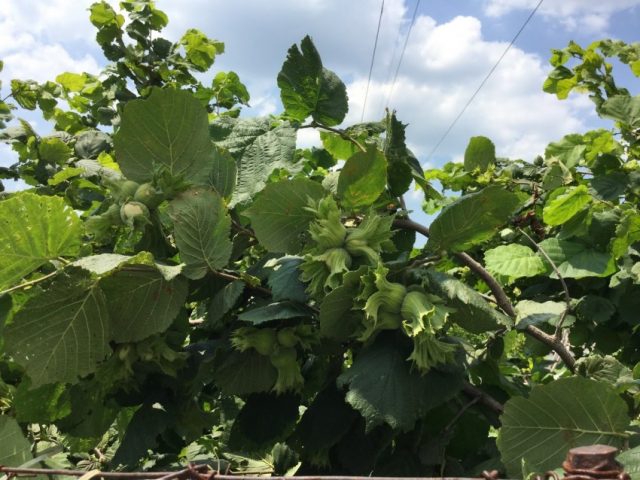
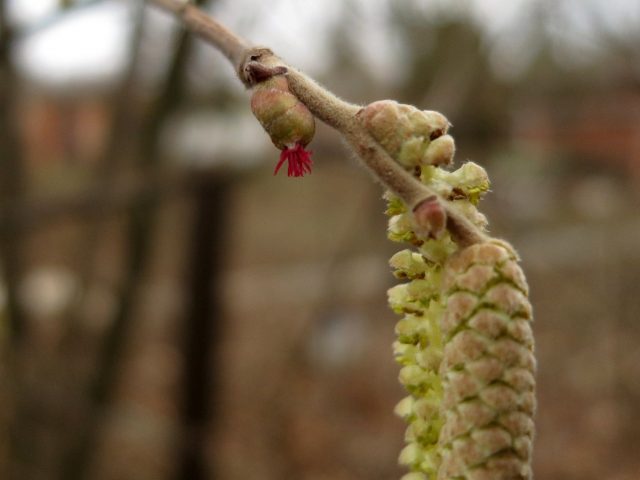
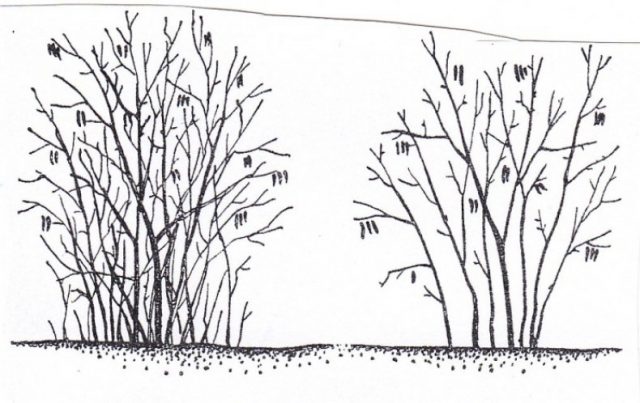
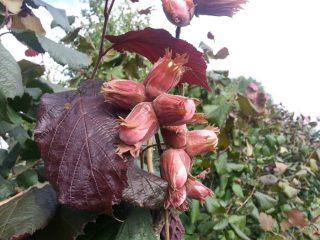
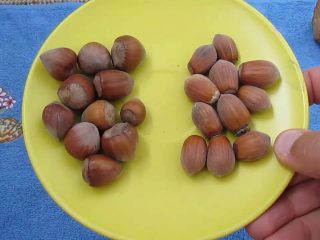
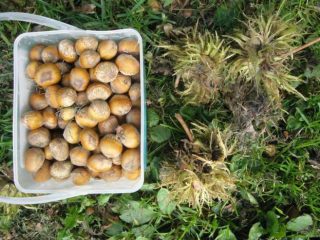
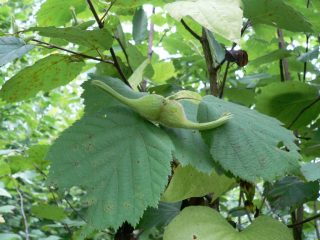
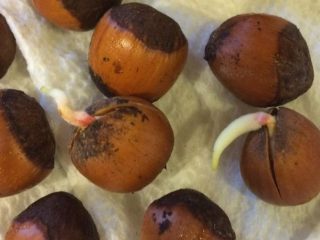
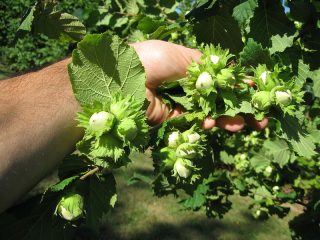

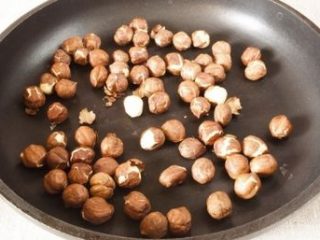

Hello. Thank you for the article. Question! Can I spray it with a solution of "ovary" or boric acid before freezing?
You can also add to the article. To bloom later than frost, put a stone or bricks. The soil will melt later.
Good day!
It is unlikely that spraying before frost will increase the percentage of pollination of female flowers. If, of course, spraying is carried out for this very purpose. Any formulations are prepared on the basis of water, and processed flowers may die in freezing. For pollination of hazel, it is best to use methods that are as close to natural as possible.
• First of all, this is the planting of pollinating varieties. Planting pollinators is necessary on the leeward side.
• Secondly, bend hazel branches to the ground for the winter and cover with snow. In this case, gardeners note a high percentage of pollination.
As for stones or bricks. Indeed, in the process of planting, stones, bricks or slate are placed in the planting pit. Here are just the reasons why this is done, gardeners cite different. Someone thinks that this will help protect the root system from groundwater. Someone believes that this event helps to shift the timing of flowering. Some believe that this helps to increase yields.
There is one more reason. When planting hazels, stones are placed so that the tree / shrub begins to bear fruit as early as possible. If, with a normal planting, the culture begins to bear fruit for 5-7 years, then with a lining of a solid base, fruiting occurs 2-3 years earlier. It is possible to put stones in the planting pits not only when planting hazels, but also other fruit and berry crops - apple trees, pears, cherries.